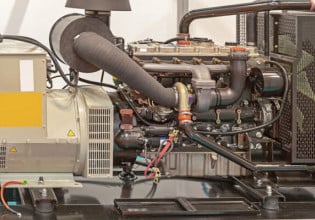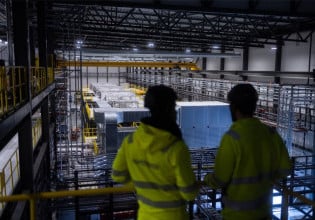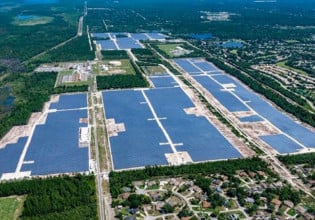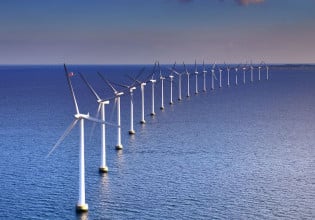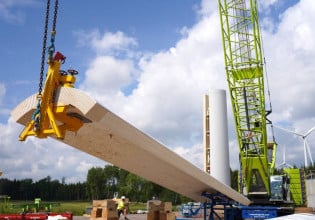Firms Seal Largest US Community Solar Deal
Following its $2.5 billion manufacturing expansion in the U.S., Qcells has landed a deal to supply 1.2 gigawatts of solar panels for Summit Ridge Energy’s 350-plus community solar projects.
Virginia-based solar developer Summit Ridge Energy has signed a supply agreement with Qcells to source 1.2 gigawatts (GW) of solar panels for more than 350 community solar projects over the next four years. The first 200 megawatts (MW) will be installed by the end of this year. Collectively, the projects are expected to power 140,000 homes and businesses.

Summit Ridge Energy’s 9.2 MW “Bomber” rooftop array in Maryland–one of the country’s largest community solar projects, serving 1,300 homes. Image used courtesy of Summit Ridge Energy
The agreement—which includes 20 MW of energy storage—is billed as the largest community solar equipment purchase in history.
Public incentives for domestic supply chains lent partial support to the deal. Though Qcells is headquartered in South Korea under its parent company, mega-conglomerate Hanwha Group, it has a significant manufacturing footprint in the U.S.
The company’s announcement mentioned it would produce “the majority” of its solar modules at its U.S. manufacturing facilities in Georgia—meeting the requirements of federal incentives in the Solar Energy Manufacturing for America Act, a portion of the Inflation Reduction Act (IRA). The $738 billion spending package passed in 2021, with over $350 billion earmarked for energy and climate-related investments.

Qcells markets high-performance solar photovoltaic cells and modules. Image used courtesy of Qcells
Boosting the U.S. Supply Chain
For scale, consider the 1.2 GW supply deal in context with America’s current community solar landscape: According to data from the Solar Energy Industries Association (SEIA), the U.S. installed 20.2 GW of solar PV capacity in 2022—reaching 142.3 GW of total installed capacity, enough to cover 25 million homes. Community solar installations, in particular, totaled 1 GW last year, down 16% from 2021. However, the SEIA expects this segment to bounce back in 2023 as delayed projects come online.
Still, America’s solar demand far exceeds its supply. U.S.-based solar module manufacturers added 1.8 GW of capacity in 2022, bringing the total to 9 GW. IRA incentives fueled part of that traction, as the SEIA expects 25 GW of IRA-supported projects to be added this year.
Supply-demand gaps are a global issue extending far beyond the community solar market. This is especially true for large-scale solar deployment targets set by public and private sectors worldwide. A group of solar power experts urged the industry to scale up to 75 terawatts of deployed PV globally. Reaching that target would require silicon solar panel producers to reduce their usage of silver to enable higher capacity production. The industry must also grow about 25% annually in the coming years.
Qcells’ Big Expansion Plans in the U.S.
This deal is part of Qcells’ ongoing expansion in America’s burgeoning renewable energy market. Capitalizing on federal incentives would boost its already-leading share of residential and commercial PV module segments.
Qcells opened a 300,000-square-foot solar assembly plant in Dalton in 2019, where it produces about 1.7 GW of modules annually. The company committed more than $2.5 billion to expand its U.S. material supply chain earlier this year. It’s building a new facility in northwest Georgia’s Bartow County to produce 3.3 GW of wafers, ingots, cells, and panels. Another expansion will add 2 GW of solar panel production at its Dalton site, growing its total capacity in the state to 8.4 GW by 2024.

A rendering of Qcells’ manufacturing facility in Georgia. Image used courtesy of Qcells
Qcells also announced in March that its solar supplier (Hanwha Advanced Materials Georgia, part of its parent company) would build a new $147 million advanced materials manufacturing plant in northwest Georgia, supplying Qcells with encapsulant film.
Video used courtesy of Qcells
Qcells and Summit Ridge Energy have been partners for years. Their last announcement was a deal for three standalone energy storage projects in Staten Island and Brooklyn, New York, producing around 12 MW and 46 MWh of capacity. Qcells agreed to supply its energy storage hardware and Geli energy management software.

Summit Ridge Energy’s 2.9-MW “Morgan 2” project in Murrayville, Illinois, is one of many community solar projects in the company’s portfolio. Image used courtesy of Summit Ridge Energy
Summit Ridge started in 2017 and has deployed over $1.6 billion in solar and battery storage assets. Its development pipeline tops 2 GW, of which more than 400 MW will be commissioned by the end of this year (powering about 50,000 homes). The company also raised a $175 million private equity round last year from funds managed by Apollo Global Management.
Broader Community Solar Goals & Market Outlook
Community solar’s selling point is allowing customers to subscribe to power produced by local solar facilities and gain credits on their utility bills. The federal government is ramping up its support for this market. The United States Department of Energy targets 5 million community solar-powered homes and $1 billion in associated energy bill savings by 2025.

The Solar Energy Industries Association expects steady growth for community solar installations through 2027. Image used courtesy of the SEIA
Overall, the SEIA expects the community solar market to more than double by 2027, driven by newly established state markets such as Virginia and New Mexico and by developers taking advantage of the Investment Tax Credit for meeting low-income and domestic content qualifications.


